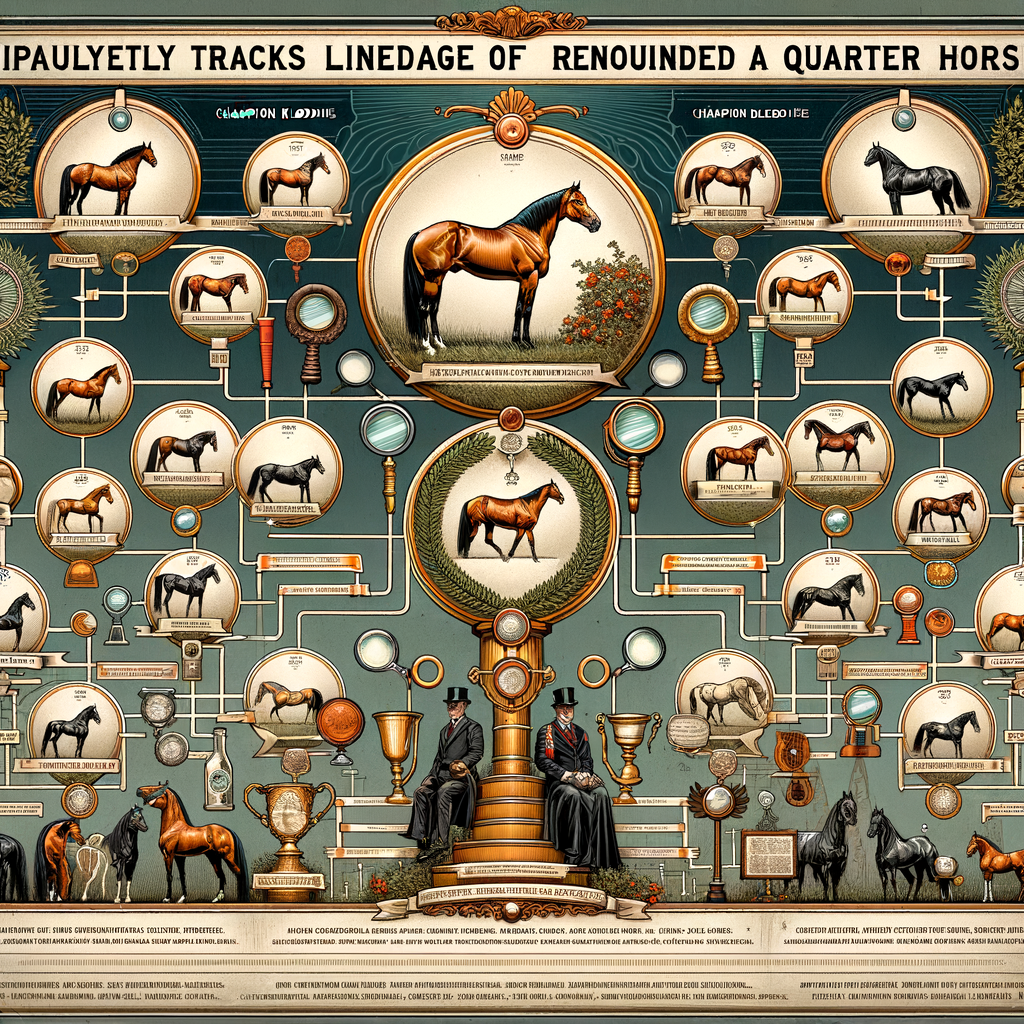
Introduction to Famous Quarter Horses
Welcome to the fascinating world of Quarter Horses, a breed that has made a significant impact in equestrian history. In this section, we will provide an overview of the Quarter Horse breed and delve into the significance of famous Quarter Horses.
-
Overview of the Quarter Horse Breed
The Quarter Horse is a breed that is renowned for its speed, agility, and versatility. Originating from the United States in the 1600s, this breed is named for its ability to outpace other breeds in races of a quarter mile or less. With a compact, muscular body and a calm, steady temperament, Quarter Horses are not only excellent racehorses but also make great work horses and show horses.
They are also known for their exceptional “cow sense,” which makes them ideal for tasks involving cattle. This breed is often seen in rodeos, horse shows, and working as ranch horses. Their versatility and friendly nature also make them popular for recreational riding.
-
Significance of Famous Quarter Horses in Equestrian History
Famous Quarter Horses have left an indelible mark on equestrian history. Their exceptional abilities and achievements have not only elevated the status of the breed but also contributed to the advancement of horse racing and other equestrian sports.
For instance, the legendary Quarter Horse ‘Easy Jet’ won 27 out of 38 races and set multiple track records. His success on the racetrack paved the way for Quarter Horses to be recognized as top-tier racehorses. Similarly, ‘Doc Bar’, another famous Quarter Horse, revolutionized the cutting horse industry with his exceptional performance and offspring.
These famous Quarter Horses and many others have not only brought fame and recognition to the breed but also significantly influenced breeding practices, training methods, and the overall development of equestrian sports.
Understanding Quarter Horse Pedigrees
When it comes to understanding the Quarter Horse breed, one of the most essential aspects to consider is the horse’s pedigree. The pedigree provides a wealth of information about the horse’s lineage, including its ancestors and their accomplishments. This knowledge can be incredibly valuable for breeders, trainers, and horse enthusiasts alike.
- Importance of Studying Quarter Horse Pedigrees
- How to Read and Interpret a Quarter Horse Pedigree
Studying a Quarter Horse’s pedigree is not just about tracing its family tree. It’s about understanding the horse’s genetic makeup, which can provide insights into its potential abilities, characteristics, and health. For instance, if a horse comes from a line of champions, it may have a higher chance of excelling in competitions.
Moreover, understanding a horse’s pedigree can help breeders make informed decisions when it comes to breeding. By pairing horses with complementary traits, breeders can enhance the positive attributes and minimize the negative ones in the offspring. Hence, studying pedigrees is a crucial part of preserving and improving the Quarter Horse breed.
Reading a Quarter Horse pedigree may seem complex at first, but with a bit of practice, it becomes easier. A pedigree chart typically displays four generations of ancestors, with the horse in question at the center. The father’s lineage is on the top, and the mother’s lineage is on the bottom.
Each horse in the pedigree is represented by a box or a circle, with the horse’s name, birth year, and achievements listed. The color of the box or circle can indicate the horse’s color and gender. A solid line between two horses signifies a direct parent-offspring relationship, while a dashed line indicates a sibling relationship.
When interpreting a pedigree, it’s important to look at the accomplishments of the ancestors. If many of them were successful in a particular discipline, the horse may have a genetic predisposition towards that discipline. However, it’s also important to remember that a pedigree is just one piece of the puzzle. Other factors, such as training, care, and environment, also play a significant role in a horse’s performance and health.
In conclusion, understanding Quarter Horse pedigrees is a fascinating and valuable aspect of appreciating this remarkable breed. It allows us to delve into the horse’s past, understand its present, and anticipate its future potential.
Champion Bloodlines: The Backbone of the Quarter Horse Breed
The Quarter Horse breed is known for its speed, agility, and versatility. But what truly sets this breed apart is its champion bloodlines. These bloodlines have played a significant role in shaping the breed and have produced some of the most notable champions in the history of horse racing.
- Role of Champion Bloodlines in shaping the Quarter Horse breed
The champion bloodlines of the Quarter Horse breed are not just about producing winners on the racetrack. They are about preserving the unique characteristics and traits that make Quarter Horses so special. These bloodlines are carefully selected and bred to ensure that the best qualities of the breed are passed down from generation to generation.
Champion bloodlines have contributed to the breed’s versatility, making Quarter Horses excel in various disciplines, from racing and rodeo events to working cattle and show jumping. They have also played a crucial role in enhancing the breed’s physical attributes, such as their muscular build, compact body, and exceptional speed.
- Examples of notable Champion Quarter Horse Lineages
There are several champion Quarter Horse bloodlines that have left a significant mark on the breed. Here are a few examples:
| Bloodline | Notable Champions |
|---|---|
| Three Bars | Known for producing speedy and versatile horses, Three Bars is the sire of many champions, including Rocket Bar and Gay Bar King. |
| Doc Bar | Doc Bar is renowned for producing excellent cutting and working horses. His progeny include Doc O’Lena and Dry Doc. |
| Impressive | Impressive is a line known for its show horses. Despite a genetic disease issue, the line has produced several World Champions, including Noble Tradition and Conclusive. |
These bloodlines, among others, have shaped the Quarter Horse breed, producing champions and preserving the breed’s unique traits. They are the backbone of the breed, ensuring its continued success and popularity.
Exploring Horse Lineages: A Closer Look at Famous Horse Bloodlines
In our exploration of horse lineages, we delve into the rich history and impact of famous horse bloodlines. One such bloodline that has left an indelible mark on the world of equine is the King Ranch bloodline.
Case Study: The Influence of the King Ranch Bloodline
Let’s take a closer look at the King Ranch bloodline, a lineage that has significantly shaped the Quarter Horse breed.
- History of the King Ranch Bloodline
- Impact of the King Ranch Bloodline on the Quarter Horse breed
The King Ranch bloodline traces its roots back to the mid-1800s, when Captain Richard King established the King Ranch in South Texas. The King Ranch was not just a cattle ranch; it was also home to a unique breed of horses. The horses of the King Ranch bloodline were bred for their strength, speed, and endurance, making them perfect for the demanding tasks on the ranch.
The King Ranch bloodline has had a profound impact on the Quarter Horse breed. The horses from this bloodline are known for their muscular build, quick speed, and exceptional cow sense. These traits have made them a popular choice for rodeo events, horse shows, and ranch work.
According to the American Quarter Horse Association, the King Ranch bloodline has contributed significantly to the development of the modern Quarter Horse. The lineage has produced numerous champions, including Wimpy, the first horse registered by the American Quarter Horse Association.
In conclusion, the King Ranch bloodline has played a pivotal role in shaping the characteristics and reputation of the Quarter Horse breed. The lineage continues to influence the breed, producing horses that excel in various equine disciplines.
Case Study: The Legacy of the Three Bars Bloodline
Let’s delve into a fascinating case study that highlights the legacy of the Three Bars Bloodline, one of the most influential in the Quarter Horse breed.
- Origins of the Three Bars Bloodline
The Three Bars bloodline traces its origins back to a Thoroughbred stallion named Three Bars. Born in 1940, this remarkable horse was bred by Walter Merrick, a well-respected figure in the horse breeding industry. Despite initial skepticism due to his Thoroughbred lineage, Three Bars went on to prove his critics wrong, demonstrating exceptional speed and athleticism that would forever change the Quarter Horse breed.
- Contributions of the Three Bars Bloodline to the Quarter Horse breed
The Three Bars bloodline has made significant contributions to the Quarter Horse breed. One of the most notable is the infusion of speed and agility into the breed. Three Bars’ descendants have consistently demonstrated these traits, leading to a new standard in Quarter Horse racing and performance.
Furthermore, the Three Bars bloodline has produced numerous champion horses. For instance, Dash For Cash, a grandson of Three Bars, won the All American Futurity twice and sired several world champions. This bloodline’s influence is so profound that it’s hard to find a modern Quarter Horse pedigree that doesn’t trace back to Three Bars.
| Key Facts about Three Bars Bloodline |
|---|
| Origin: Three Bars, a Thoroughbred stallion |
| Key Contribution: Infused speed and agility into the Quarter Horse breed |
| Notable Descendant: Dash For Cash, a two-time All American Futurity winner |
In conclusion, the legacy of the Three Bars bloodline is deeply woven into the fabric of the Quarter Horse breed. Its influence continues to shape the breed, demonstrating the enduring power of a strong bloodline.
Quarter Horse Champions: Celebrating Excellence
As we delve deeper into the world of Quarter Horses, we cannot overlook the champions that have shaped the breed and left an indelible mark on equestrian sports. These horses, with their exceptional abilities and unique characteristics, have not only won numerous accolades but have also influenced the breed’s development and performance in various equestrian events.
- Profiles of Notable Quarter Horse Champions
Let’s take a moment to celebrate some of the most notable Quarter Horse champions that have graced the equestrian world.
| Horse Name | Achievements |
|---|---|
| Wimpy | Known as the first registered Quarter Horse, Wimpy was a champion sire, producing many successful offspring. |
| Easy Jet | A racing legend, Easy Jet won 27 of his 38 starts, including the All American Futurity, the most prestigious race for Quarter Horses. |
| Impressive | Impressive was a show ring star, known for his muscular build and beautiful conformation. His genetics continue to influence the breed today. |
These champions, among others, have significantly contributed to the Quarter Horse breed, setting standards in performance, conformation, and temperament.
- Impact of these Champions on the Breed and Equestrian Sports
The influence of these champions on the Quarter Horse breed and equestrian sports is profound. Their exceptional performance has set high standards for the breed, inspiring breeders and trainers to strive for excellence. Their success in various equestrian events has also highlighted the versatility of the Quarter Horse breed, demonstrating their ability to excel in racing, showing, and working events.
Moreover, the genetic contributions of these champions have shaped the breed’s development. For instance, the muscular build of Impressive has become a sought-after trait in show Quarter Horses. Similarly, the speed and endurance of Easy Jet have influenced the breeding of racing Quarter Horses.
In conclusion, the Quarter Horse champions are the pillars of the breed’s excellence. Their legacy continues to inspire and shape the future of the Quarter Horse breed and equestrian sports.
Studying Quarter Horse Pedigrees: A Guide for Enthusiasts
For those who have a deep appreciation for the Quarter Horse breed, studying their pedigrees can be an enlightening and rewarding experience. It not only provides a historical perspective but also enhances the understanding and appreciation of the breed’s unique characteristics.
- Resources for Studying Quarter Horse Pedigrees
There are several resources available for studying Quarter Horse pedigrees. Books, online databases, and breed registries can provide comprehensive information about the lineage of these horses. For instance, the American Quarter Horse Association (AQHA) maintains a detailed database of Quarter Horse pedigrees, which is a valuable resource for enthusiasts.
| Resource | Description |
|---|---|
| American Quarter Horse Association (AQHA) | The AQHA provides a comprehensive database of Quarter Horse pedigrees, including details about lineage, performance, and awards. |
| Books on Quarter Horse Pedigrees | There are several books available that provide detailed information about Quarter Horse pedigrees, including their history, famous bloodlines, and champion horses. |
| Online Databases | Various online databases provide access to Quarter Horse pedigrees, often including photos, performance records, and lineage details. |
- How Studying Pedigrees Can Enhance Appreciation for the Breed
Studying pedigrees allows enthusiasts to understand the lineage of a horse, tracing back its ancestors and their achievements. This knowledge can enhance the appreciation for the breed, as it provides insights into the genetic traits, performance capabilities, and unique characteristics of the Quarter Horse breed.
For example, understanding a horse’s pedigree can reveal why a particular horse excels in racing, cutting, or reining. It can also provide insights into the horse’s temperament, health, and potential for success in various equestrian disciplines. Thus, studying pedigrees is not just about tracing lineage, but also about understanding the breed’s history, achievements, and potential.
In conclusion, studying Quarter Horse pedigrees is a fascinating journey into the history and heritage of this remarkable breed. It enhances the appreciation for the breed and provides valuable insights into their unique characteristics and capabilities.
Quarter Horse Heritage: Preserving the Legacy
The Quarter Horse breed has a rich and storied history, with a legacy that stretches back centuries. This legacy is something that horse enthusiasts, breeders, and organizations are working tirelessly to preserve and promote. Let’s explore the various efforts being made to safeguard the Quarter Horse heritage and the role that enthusiasts and breeders play in this important task.
- Efforts to Preserve and Promote the Quarter Horse Heritage
Preserving the Quarter Horse heritage is a task that involves many different aspects. From maintaining the purity of the breed and promoting its unique characteristics, to educating the public about its history and significance, there are numerous ways in which this heritage is being safeguarded.
Organizations like the American Quarter Horse Association (AQHA) play a crucial role in this. They maintain a comprehensive database of Quarter Horse pedigrees, ensuring the integrity of the breed. They also organize events and shows that showcase the abilities and versatility of Quarter Horses, helping to promote the breed and its heritage.
Education is another key aspect of preservation. By teaching people about the history of the Quarter Horse, its role in American history, and its unique characteristics, we can foster a deeper appreciation for the breed and its heritage.
- Role of Enthusiasts and Breeders in Preserving the Quarter Horse Heritage
Enthusiasts and breeders play a pivotal role in preserving the Quarter Horse heritage. Breeders, in particular, are the custodians of the breed. They have the responsibility of ensuring that the Quarter Horses they breed are true to the breed’s standards, thereby maintaining its purity and integrity.
Enthusiasts, on the other hand, help to promote the breed and its heritage. By participating in shows, events, and competitions, they showcase the abilities of Quarter Horses to a wider audience. They also help to educate the public about the breed, sharing their knowledge and passion for Quarter Horses with others.
Both breeders and enthusiasts are crucial in the ongoing efforts to preserve and promote the Quarter Horse heritage. Their dedication and passion for this breed ensure that the legacy of the Quarter Horse will continue to be celebrated for generations to come.
Conclusion: The Enduring Legacy of Famous Quarter Horses
As we reach the end of our journey exploring the world of famous Quarter Horses, it’s essential to reflect on the impact they’ve made and the future that lies ahead for this remarkable breed.
- Reflection on the History and Impact of Famous Quarter Horses
From the early days when they raced on quarter-mile tracks, hence their name, to their current status as versatile, all-around performers, Quarter Horses have left an indelible mark on the equine world. Their speed, agility, and calm demeanor have made them a favorite among horse enthusiasts, ranchers, and competitive riders alike.
Notable Quarter Horses like Wimpy, the first registered Quarter Horse, and Easy Jet, a champion racehorse, have set the bar high for future generations. Their accomplishments have not only brought fame to the breed but also contributed to its development and refinement.
Quarter Horses have also made significant contributions to various equine sports. Their agility and speed make them ideal for rodeo events, while their calm and trainable nature makes them excellent for trail riding and therapeutic riding programs.
- Future Prospects for the Quarter Horse Breed
Looking ahead, the future of the Quarter Horse breed seems bright. With continued advancements in breeding technology and genetic research, we can expect to see even more improvements in the breed’s health, longevity, and performance abilities.
Moreover, the enduring popularity of Quarter Horses ensures that they will continue to be a staple in various equine disciplines. From rodeo events to dressage competitions, Quarter Horses are likely to remain a favorite among riders of all ages and skill levels.
As we continue to celebrate and preserve the legacy of famous Quarter Horses, let’s also look forward to the exciting possibilities that the future holds for this remarkable breed.









